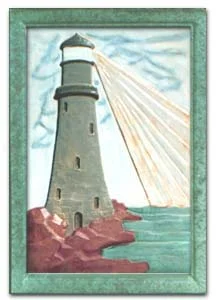How "The Roosevelts" Reminded Me of Arts-based Curriculum.
Watching Ken Burns' "The Roosevelts" on WETA was a deep dip into the wise waters of liberal progressivism, While no one wants government to be "Big Brother", and we all have varying opinions on what Big Brotherism is, I have always had positive feelings about the New Deal. My parents' memories of their own poverty during the Depression, and their belief that FDR was responsible for their being moved to the new, clean public housing projects where they met, certainly influenced my thinking. One of FDR's signature programs in the early '30's was the Works Projects Administration. The above is one of the WPA mosaic tiles built into the walls of the North End Pavilion at Spring Lake (NJ) Beach. That pavilion was totally destroyed by Hurricane Sandy. The tiles, we heard, had been removed for safe-keeping before the storm. The new pavilion is an almost exact replica of the old one, which is such a joy to those of us who thought that a new construction would be a new look. Even better, there are replicas of the old tiles in place. To those of us who love the Jersey Shore, this was the right thing to do.
New and original architecture, and new art are good for culture and society. New and original people are, too! Once the WPA employed artists were the breath of fresh air, the innovators, the vanguard of art in the early 20th century. When I think of how the government actually financed them, I feel such pride that the U.S. Government saw employment of artists as equally important as employment of steel workers or machinists. This attitude towards the arts has not been carried along into the new century.
Ironically, teaching through the arts has been shown in research to be the most integrating path to healthy, mature and consistent learning. I find that using the arts as a pathway motivates students to bring all of their own "human capital" to their efforts. Just as those early WPA artists, paid by Uncle Sam, threw their best efforts into working with other craftsmen to produce useful and beautiful buildings, our students will work through the arts to produce beautiful "products" that demonstrate what they have learned. New and original people are the human product of this approach.
Teaching through arts integration is rigorous. Students must address learning standards in both the arts and in other subjects, such as history, literature, science and math. They use their hands, bodies, voices, feelings AND intellect in the learning process. This is what we call on the Early Childhood field integrated curriculum. There are many ways teachers can learn this approach, one being at the Kennedy Center's CETA (Changing Education Through the Arts) program. Becoming a CETA school means getting teaching artists into your building. Wolf Trap also works with schools to train teachers to teach through the arts. There are many online resources ask well.
An old building is not always worth replicating. Certainly old teaching methods aren't, either. We need to teach to the whole person, preserving the best the arts and education have to offer. Let's not ignore this challenge.



Comments